Kristen Elise's Blog, page 12
June 6, 2013
Print Books vs. EBooks - Don't Forget Fonts!
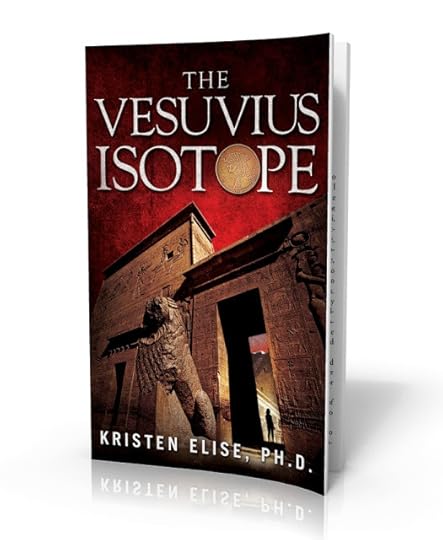 CreateSpace, here we come!
CreateSpace, here we come!How cool is Damonza's Awesome Book Covers? The ebook is being formatted, and the formatting for the print book is DONE! The copyright has been registered and the novel has been uploaded to CreateSpace. I can't wait to see the proof.
For all of you e-book people, I want to give you a heads up about something: The print book for The Vesuvius Isotope will be soooooo much cooler. I ended up with FIVE different fonts in this text:
1. Bookman Old Style for all regular text, frequently italicized.2. Copperplate Bold for all ancient documents.3. Courier New for all text messages and e-mails.4. Herculaneum (no WAY I could have NOT written this font into this book...) for a couple of ancient mosaics and section breaks.5. Mistrel as part of the Murder Lab Press logo.
Now here's the bad news. E-books don't allow this. I had to pick one font and go with it (in fact, I didn't even get to pick it, now that I think about it.) So italics and bold are the only options for distinguishing one text from another. So...the Copperplate sections became simply bold, and the other three fonts went the way of the dodo. Which is fine - it's still good reading - but not nearly as visually cool in my humble opinion.
Published on June 06, 2013 18:49
June 3, 2013
A Journey to the Real Dante's Inferno: The Phlegraean Fields
A deep cave there was, yawning wide and vast, of jagged rock, and sheltered by dark lake and woodland gloom, over which no flying creatures could safely wing their way; such a vapour from those black jaws was wafted to the vaulted sky whence the Greeks spoke of Avernus, the Birdless Place.
-The Aeneid, Virgil (70–19 BCE)
It's not trick videography. Lake Avernus really is black. That and the sulfurous fumes emitted from the lake were certainly the inspiration for its name. Avernus - from the Greek for "No Birds" - takes its moniker from the widely-held ancient belief that birds flying over the lake would drop dead out of the sky from the fumes. The video above proves the existence of fowl, but the lake is still - well, foul.
Lake Avernus is just one noteworthy feature of Campania's Phlegraean Fields - or, as I like to refer to them, the Phlegm Fields. This lesser-visited area outside of Naples, Italy, is perhaps one of the more interesting sites for those seeking myth and macabre off the beaten path.
It is widely known that Dante Alighieri was from Florence. But it is hypothesized that his idea for the Inferno came from this area. In addition to the black Lake Avernus, the Phlegraean Fields feature Sybil's Grotto - thought to be the gateway to the underworld - an area of natural steam geysers known as Sulfatara, and belching, sulfurous, boiling lakes of mud. The geothermal activity in the area is, of course, attributed to Mount Vesuvius, and serves as a constant reminder that the volcano can erupt again at any time.
The second video is long, but some of the features of the Phlegm Fields are shown in the first five minutes. At 0.58, we see pockets of steam emerging from within the earth, and are surprised that the word "dormant" is used to describe the Solfatara crater. From about 2:42 forward, we are introduced to the multiple pockets of mud; 3:02 shows that some of them are actually boiling. Facial, anyone?
This blog post explores a non-fictional theme or locale that is incorporated in The Vesuvius Isotope, a novel by Kristen Elise. PRE-ORDER your copy using the "Buy Now" icon on the right hand side of this page.
-The Aeneid, Virgil (70–19 BCE)
It's not trick videography. Lake Avernus really is black. That and the sulfurous fumes emitted from the lake were certainly the inspiration for its name. Avernus - from the Greek for "No Birds" - takes its moniker from the widely-held ancient belief that birds flying over the lake would drop dead out of the sky from the fumes. The video above proves the existence of fowl, but the lake is still - well, foul.
Lake Avernus is just one noteworthy feature of Campania's Phlegraean Fields - or, as I like to refer to them, the Phlegm Fields. This lesser-visited area outside of Naples, Italy, is perhaps one of the more interesting sites for those seeking myth and macabre off the beaten path.
It is widely known that Dante Alighieri was from Florence. But it is hypothesized that his idea for the Inferno came from this area. In addition to the black Lake Avernus, the Phlegraean Fields feature Sybil's Grotto - thought to be the gateway to the underworld - an area of natural steam geysers known as Sulfatara, and belching, sulfurous, boiling lakes of mud. The geothermal activity in the area is, of course, attributed to Mount Vesuvius, and serves as a constant reminder that the volcano can erupt again at any time.
The second video is long, but some of the features of the Phlegm Fields are shown in the first five minutes. At 0.58, we see pockets of steam emerging from within the earth, and are surprised that the word "dormant" is used to describe the Solfatara crater. From about 2:42 forward, we are introduced to the multiple pockets of mud; 3:02 shows that some of them are actually boiling. Facial, anyone?
This blog post explores a non-fictional theme or locale that is incorporated in The Vesuvius Isotope, a novel by Kristen Elise. PRE-ORDER your copy using the "Buy Now" icon on the right hand side of this page.
Published on June 03, 2013 07:18
May 30, 2013
The Naples Archeological Museum: A Virtual Visit
For anyone with an interest in Pompeii and Herculaneum, a visit to Naples is a must. Inside the Naples Archeological Museum is the world's largest collection of artifacts unearthed from the ancient cities lost tragically in the 79 AD eruption of Mount Vesuvius. But for those who can't fly to Italy this week, here we revisit a Rick Steves video detailing some of the highlights in the museum.
Steves comments in the beginning of the video that "the local king" demanded that the best treasures be excavated from Pompeii, Herculaneum and Stabiae. This is a partial truth. The rest of the story is that King Charles was acting on the authority of his mother.
Queen Elisabetta was descended from the Medici dukes of Florence and the Farnese dukes of Lombardy. It was Elisabetta who initiated and funded the first excavations of these cities in the 1700s, and the priceless Farnese collection available to Archeological Museum visitors today (mentioned at around 3:45 in the video) was her own.
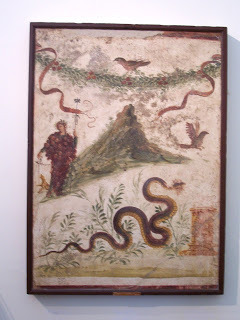 Mount Vesuvius before the eruptionAt 0.49, we see one of the most famous frescoes from Pompeii. The beauty of this piece is that it shows Mount Vesuvius as the Romans saw the volcano, covered in foliage and apparently dormant. Prior to the eruption that buried the Roman cities, Mount Vesuvius had not erupted since about 1800 BC. The Roman citizens of Pompeii and Herculaneum were totally ill prepared when it happened.
Mount Vesuvius before the eruptionAt 0.49, we see one of the most famous frescoes from Pompeii. The beauty of this piece is that it shows Mount Vesuvius as the Romans saw the volcano, covered in foliage and apparently dormant. Prior to the eruption that buried the Roman cities, Mount Vesuvius had not erupted since about 1800 BC. The Roman citizens of Pompeii and Herculaneum were totally ill prepared when it happened.Since that eruption, Mount Vesuvius has erupted several more times. In 2010, it was predicted that another major eruption will occur within the next eight years. We are getting very close to that day.
Why, then, do so many priceless artifacts still remain beneath the ash? At 0.54 of the video, we see several bronze statues from the villa of Julius Caesar's father-in-law. What Rick Steves neglects to mention here is that this was the famed "Villa dei Papiri," the most extensive ancient Roman library still extant today. The fact that the majority of this library is still buried beneath a volcano that could erupt again at any time is a tragedy waiting to happen. The history of the excavation of this villa, and the reasons why it has not been fully excavated, are discussed here.
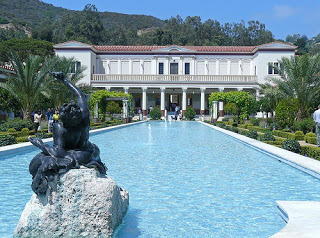 Despite the fact that efforts to excavate the Villa dei Papiri have been repeatedly halted throughout the centuries, the many voyages into the villa have offered a very complete description of it. Visitors to the Getty Villa in Malibu, California, have the luxury of seeing this grandiose palace as it was in the time of the Romans. The Getty Villa is a museum dedicated to artifacts from Pompeii and Herculaneum, and the museum itself is a full-scale reconstruction of the three-story Villa dei Papiri. One can meander through the vast gardens of the Getty Villa and find a reproduction of the Drunken Faun statue mentioned at 1:18 of the Rick Steves video.
Despite the fact that efforts to excavate the Villa dei Papiri have been repeatedly halted throughout the centuries, the many voyages into the villa have offered a very complete description of it. Visitors to the Getty Villa in Malibu, California, have the luxury of seeing this grandiose palace as it was in the time of the Romans. The Getty Villa is a museum dedicated to artifacts from Pompeii and Herculaneum, and the museum itself is a full-scale reconstruction of the three-story Villa dei Papiri. One can meander through the vast gardens of the Getty Villa and find a reproduction of the Drunken Faun statue mentioned at 1:18 of the Rick Steves video.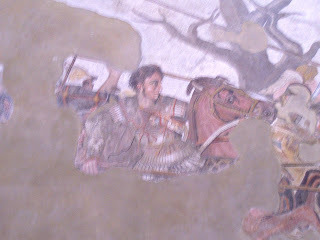 Alexander the Great mosaic from Pompeii
Alexander the Great mosaic from PompeiiAt 2:04, we see one of the most priceless mosaics from Pompeii: the mosaic that depicts the victory of Alexander the Great over Persia. Of course, it was Alexander who founded the Egyptian city known today as Alexandria, and it was his legacy that followed through 250 years of Ptolemaic pharaohs to the last ruler of the dynasty, Queen Cleopatra.
This mosaic was found in the House of the Faun, an extraordinarily large Pompeii villa that could only have been owned by the highest of elite. Exactly who owned the House of the Faun has never been established, but the Alexander the Great mosaic was not the only Egyptian influence found there. Other notable artwork excavated from the villa included several scenes of the Nile river.
No discussion of the Naples Archeological Museum would be complete without mention of the Secret Room, which requires an additional fee to enter. Rick Steves brings the viewer into this room for free at 2:45 in the video. The Secret Room contains much of the erotic art from Pompeii, of which there was plenty.
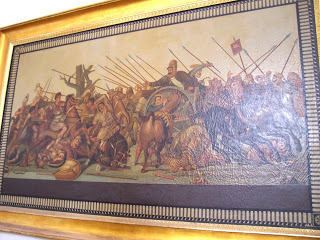 Reconstruction of the Alexander the Great mosaicOne section of the museum not mentioned in the video is the Egyptian section. Along with a respectable collection of ancient Egyptian artifacts, this section contains human and animal mummies and a bit of information about the mummification beliefs of the pharaohs. Contained within the mummified crocodile is a delicious secret. Stay tuned.
Reconstruction of the Alexander the Great mosaicOne section of the museum not mentioned in the video is the Egyptian section. Along with a respectable collection of ancient Egyptian artifacts, this section contains human and animal mummies and a bit of information about the mummification beliefs of the pharaohs. Contained within the mummified crocodile is a delicious secret. Stay tuned.To visit the Naples Archeological Museum, visit the museum's Official Site.
This blog post explores a non-fictional theme or locale that is incorporated in The Vesuvius Isotope, a novel by Kristen Elise. PRE-ORDER your copy using the "Buy Now" icon on the right hand side of this page.
Published on May 30, 2013 09:20
May 23, 2013
The Buried Books of Herculaneum: A Novel Travelist Mystery
In a glass case within the Naples Archaeological Museum is an instrument that resembles an old, battered loom. Long, knotted strands of a charcoal-colored substance hang suspended from it. The cluster looks more like meat curing in a slaughterhouse than what it actually is. It is paper.
This display is dedicated to the Villa dei Papyri, an ancient Roman residence buried and immaculately preserved in the 79AD eruption of Mt. Vesuvius. The villa just happened to be owned by the father-in-law of Julius Caesar.
Inside the Villa dei Papyri was a large library containing approximately two thousand papyrus scrolls. Since their discovery in the 1700s, scientists and historians alike have repeatedly undertaken the unwinding of these precious artifacts. Once unwound, they are still legible.
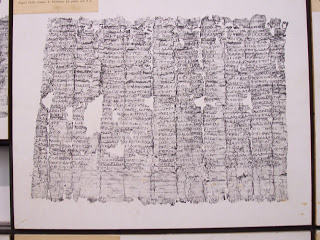 A papyrus scroll from the Villa dei PapyriIn addition to the large Greek library already uncovered, it is believed that there was probably an entire section of the library dedicated to works written in Latin, which of course may have included those of Julius Caesar himself. It may also contain the works of Octavian, the great nephew of Caesar and his sole heir, who went on to become the first Roman Emperor, Augustus. And the Villa dei Papyri may contain the writings of Caesar's lover and the mother of his only known son: Cleopatra, the enigmatic, powerful, multilingual, highly educated queen from whom no single writing has ever been discovered.
A papyrus scroll from the Villa dei PapyriIn addition to the large Greek library already uncovered, it is believed that there was probably an entire section of the library dedicated to works written in Latin, which of course may have included those of Julius Caesar himself. It may also contain the works of Octavian, the great nephew of Caesar and his sole heir, who went on to become the first Roman Emperor, Augustus. And the Villa dei Papyri may contain the writings of Caesar's lover and the mother of his only known son: Cleopatra, the enigmatic, powerful, multilingual, highly educated queen from whom no single writing has ever been discovered. But if these works do exist, they are still buried.
The majority of the villa was never fully excavated. Over the centuries, the treasure within has been sought by the likes of King Charles of Campania, Napoleon Bonaparte and Benito Mussolini. Tunnels have been excavated and then back-filled. The villa has been bombed, excavated, and bombed again. But the majority of the library remains intact, beneath meters of hardened ash from Mount Vesuvius.
I pose here the question: why? Why, when the Villa dei Papyri may be one of the most important archeological finds, and resources, in European history? Why, when many other areas of Herculaneum have been fully excavated for centuries? Why, when today's technology can readily bore into the depths of the Earth?
You are invited to join us in solving this Novel Travelist Mystery: Why was the Villa dei Papyri never fully excavated? To follow the mystery, visit part 2 at Novel Travelist.
Look here for clues:
The Naples Archeological Museum, Naples, Italy
The Getty Villa, Malibu, California
The Greco-Roman Museum, Alexandria, Egypt
Pompeii Awakened, by Judith Harris
Kristen Elise is the author of the forthcoming novels The Vesuvius Isotope and The Death Row Complex. This Novel Travelist Mystery is one of the themes explored in The Vesuvius Isotope. Look for it in July, 2013.
Published on May 23, 2013 09:15
May 22, 2013
What type of cancer do you work on?
 Are you writing a science thriller? What about a mystery with a forensic component? If you're seeking advice from an expert in the sciences, look no farther than Katrina Stone, professional biologist and protagonist of "The Vesuvius Isotope." To learn more about Katrina's areas of expertise, click here. To ask a question of your own, click here. Below, a reader asks:
Are you writing a science thriller? What about a mystery with a forensic component? If you're seeking advice from an expert in the sciences, look no farther than Katrina Stone, professional biologist and protagonist of "The Vesuvius Isotope." To learn more about Katrina's areas of expertise, click here. To ask a question of your own, click here. Below, a reader asks:
What type of cancer do you work on?
Katrina's answer:
I do not work on a specific type of cancer. I work in early stage drug discovery – that is, finding the best drug in the first place, long before it enters human clinical trials. Once it enters the clinic, a cancer drug goes first into “Phase I”. Phase I trials are safety trials, but they also guide clinicians toward an “indication” (type of cancer) that seems appropriate for that drug. So, the majority of cancer drugs find their niche in Phase II of the clinic. This is several years after the drug has left my hands.
However, early stage discovery efforts (my focus) are frequently geared toward looking for a drug that will be applied to a certain indication. To pick this indication, we balance the probability of success (is it a cancer that CAN be treated?) with unmet medical need (are there enough patients that have this type of cancer?) and other factors.
Published on May 22, 2013 09:21
May 17, 2013
Cover Reveal: The Vesuvius Isotope
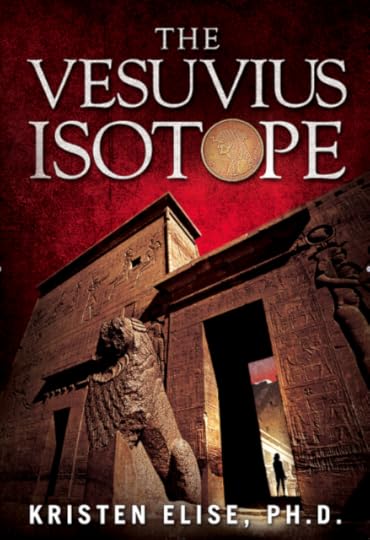 In the ruins of Herculaneum lies the Villa dei Papiri, a sprawling palace once owned by the father-in-
In the ruins of Herculaneum lies the Villa dei Papiri, a sprawling palace once owned by the father-in-law of Julius Caesar. In the 79CE eruption of Mount Vesuvius, the villa and its extensive library were buried and perfectly preserved. Today, they have been partially excavated. The thousands of documents within the library are still legible.
A document unearthed from within the Villa dei Papiri has just been translated. The document describes an ancient remedy for metastatic cancer in women. It was authored by Julius Caesar's last lover, Queen Cleopatra VII. It is, in fact, the only written text that has ever been attributed to the highly educated, multilingual and scientifically-minded last ruler of Ptolemaic Egypt.
The two-thousand-year-old remedy described in the document is the only hope for thousands today.
When her Nobel Laureate husband is murdered, drug discovery biologist Katrina Stone can no longer ignore the secrecy that has increasingly pervaded his recent behavior. Her search leads first to another woman, and then to the two-thousand-year-old document. As Katrina races to solve her husband's murder, she is led from ancient Italy and Egypt into the modern-day conflict that her husband was killed for. And she learns that his death was only the beginning.
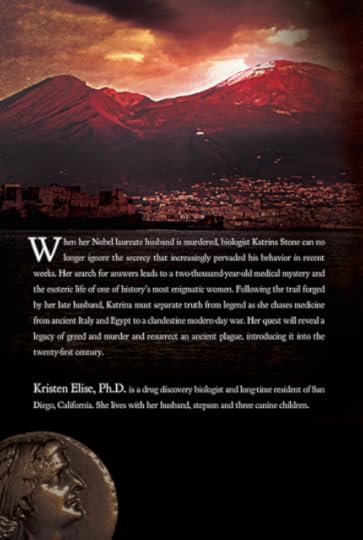 The temple on the front cover of The Vesuvius Isotope is the Temple of Isis at Aswan, Egypt. On the right hand side of the image is a relief of the goddess Isis herself. This goddess, the ancient Egyptian goddess of medicine, was adopted by Cleopatra when the queen publicly deemed herself "the New Isis" during her reign over Egypt.
The temple on the front cover of The Vesuvius Isotope is the Temple of Isis at Aswan, Egypt. On the right hand side of the image is a relief of the goddess Isis herself. This goddess, the ancient Egyptian goddess of medicine, was adopted by Cleopatra when the queen publicly deemed herself "the New Isis" during her reign over Egypt.The coin on the front cover is a typical, modern depiction of Cleopatra. But the coin on the back cover is the actual image of her. It is this coin that Cleopatra minted during her reign. It is this image that she chose to project for posterity.
Far from the sexy seductress of Hollywood, the queen was not, in fact, considered the least bit attractive by her own peers. How, then, did she so cleverly manipulate the two most powerful Romans in the world - first Julius Caesar, and then Mark Antony? The answer to this question lies in The Vesuvius Isotope.
I would like to thank Damonza's Awesome Book Covers for the Awesome Book Cover. You can now pre-order The Vesuvius Isotope using the icon to your right. Please expect shipment approximately July 1.
Published on May 17, 2013 09:13
May 16, 2013
The Vesuvius Isotope Now Available For Pre-Order!
 Click the button on the right that looks like this - NOT this one!There's a new little icon to your right! -------------->
Click the button on the right that looks like this - NOT this one!There's a new little icon to your right! -------------->You may now pre-order The Vesuvius Isotope in paperback form only, right here on this website. This will always be your cheapest option for obtaining the novel, as there's no middle-man to receive a cut of your money. e-books will become available in the next month or so.
As my author friends know, it's tough to set a definitive launch date for these things. To be safe, I'm estimating July 1. Please expect your pre-ordered copies to ship around that time. When you place your order, you will have several shipping options and then you will come to a box that lets you enter names for who you would like your signed copy addressed to. You're also always welcome to e-mail me with further specifics.
Also coming soon is the cover reveal, which will occur in the next day or so. I'm not ashamed to tease you a little by saying...I LOVE the way this cover turned out. I can take no credit, as the brilliant design is attributed entirely to Damonza's Awesome Book Covers. The cover is indeed awesome! Stay tuned!
Last, please note that I have uploaded a *new* free sample to my "The Vesuvius Isotope Sample" page on this site. The new sample contains Chapters 1 and 2 (previously, you only got to see Chapter 1), so please feel free to read that in advance of the delivery of the full-length novel.
Thank you so much for your interest, and I hope you enjoy reading The Vesuvius Isotope!
Kris
Published on May 16, 2013 10:09
May 14, 2013
Writing - check! Editing - check!
Just an announcement: The Vesuvius Isotope is officially AT THE FORMATTER!
Can't wait can't wait can't wait can't wait can't wait can't wait
Can't wait can't wait can't wait can't wait can't wait can't wait
Published on May 14, 2013 14:36
May 10, 2013
This Weekend! The Mysterious Galaxy 20th Birthday Gala

San Diegans, don't miss this event at Mysterious Galaxy this Saturday, May 11th! I will be there to support an awesome indie bookstore and my fellow authors. Hope to see you there!
Click here for details
Published on May 10, 2013 11:39



